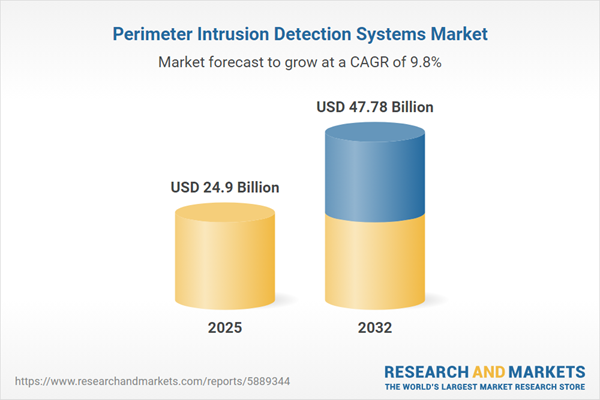Speak directly to the analyst to clarify any post sales queries you may have.
Perimeter intrusion detection systems are becoming integral to safeguarding critical assets as organizations adapt to increasingly complex security challenges. Senior decision-makers can rely on this comprehensive market intelligence to guide strategic investment and operational resilience.
Market Snapshot: Perimeter Intrusion Detection Systems Market Analysis
The perimeter intrusion detection systems market grew from USD 22.66 billion in 2024 to USD 24.90 billion in 2025. With a projected compound annual growth rate (CAGR) of 9.77%, the market is poised to reach USD 47.78 billion by 2032. This sustained momentum is driven by heightened regulatory expectations, an evolving threat landscape, and technological breakthroughs that create new opportunities and challenges for end users and solution providers alike. Organizations across sectors are recalibrating their security strategies in response to converging cyber-physical risks, regulatory pressures, and the need for advanced, scalable solutions.
Scope & Segmentation
- Technologies: Dual technology (including fiber optic radar, microwave infrared), fiber optic, infrared, microwave, radar, video surveillance (cloud analytics, edge analytics).
- End User Industries: Commercial, government, industrial, residential, transportation.
- Deployment Modes: Exterior, interior adaptations for varied facility types and environmental exposures.
- Applications: Asset protection, border security, critical infrastructure protection, facility surveillance, perimeter monitoring.
- Installation Types: New installations, retrofit applications accommodating modern sensor arrays and analytic engines.
- Regional Coverage: Americas (North America: United States, Canada, Mexico; Latin America: Brazil, Argentina, Chile, Colombia, Peru), Europe, Middle East & Africa (Europe: United Kingdom, Germany, France, Russia, Italy, Spain, Netherlands, Sweden, Poland, Switzerland; Middle East: United Arab Emirates, Saudi Arabia, Qatar, Turkey, Israel; Africa: South Africa, Nigeria, Egypt, Kenya), Asia-Pacific (China, India, Japan, Australia, South Korea, Indonesia, Thailand, Malaysia, Singapore, Taiwan).
- Industry Leaders Analyzed: Hangzhou Hikvision Digital Technology, Zhejiang Dahua Technology, Bosch Sicherheitssysteme, Honeywell International, Johnson Controls, Teledyne FLIR, Axis Communications, Carrier Global, Senstar Corporation, Motorola Solutions.
Key Takeaways for Senior Decision-Makers
- Adoption of integrated and hybrid sensor platforms is reshaping how organizations detect and respond to evolving physical and cyber threats.
- Technological innovation, including the integration of artificial intelligence-powered analytics and unmanned platforms, supports real-time monitoring and predictive maintenance.
- End users across sectors are seeking modular and interoperable solutions to future-proof security environments while minimizing operational disruption.
- Industry shifts such as increased regulatory focus toward standardized performance metrics and incentives for domestic capacity impact supplier strategies and procurement frameworks.
- Regional diversity influences adoption patterns, with markets in the Americas, EMEA, and Asia-Pacific exhibiting distinct regulatory, technological, and operational requirements.
- Industry leadership is being determined by companies able to forge strategic partnerships, leverage R&D, and rapidly adapt to compliance and threat scenario shifts.
Tariff Impact: Navigating the 2025 United States Tariff Adjustments
United States tariff adjustments in 2025 on imported security equipment components are prompting organizations to revamp sourcing strategies and cost management. Supply chain resilience has become a priority, driving a shift toward alternative procurement channels, hybrid manufacturing models, and strategic stockpiling of critical components. These changes are encouraging the exploration of onshoring and partnership-based sourcing to buffer cost fluctuations and maintain competitive positioning within the perimeter intrusion detection systems marketplace.
Methodology & Data Sources
This report is built on a robust research framework combining in-depth interviews with industry professionals, rigorous quantitative surveys, and validation against authoritative industry documents. Independent expert review ensures that insights are both empirically grounded and objectively assessed, offering clarity and actionable recommendations for stakeholders in the perimeter intrusion detection systems market.
Why This Report Matters: Actionable Value for Decision-Makers
- Identify growth opportunities and avoid common pitfalls by understanding how market, regulatory, and technology trends are shaping the future of perimeter intrusion detection solutions.
- Leverage nuanced segmentation and competitive analysis to refine sourcing, supplier, and deployment strategies tailored to your organization’s needs.
- Translate actionable recommendations into improved operational efficiency, regulatory alignment, and risk mitigation for mission-critical assets.
Conclusion
The perimeter intrusion detection systems market is entering a phase of accelerated innovation, integration, and regional customization. Decision-makers equipped with current insights will be well positioned to optimize protection strategies and sustain resilient, adaptive operations in a dynamic security environment.
Additional Product Information:
- Purchase of this report includes 1 year online access with quarterly updates.
- This report can be updated on request. Please contact our Customer Experience team using the Ask a Question widget on our website.
Table of Contents
3. Executive Summary
4. Market Overview
7. Cumulative Impact of Artificial Intelligence 2025
Companies Mentioned
The companies profiled in this Perimeter Intrusion Detection Systems market report include:- Hangzhou Hikvision Digital Technology Co., Ltd.
- Zhejiang Dahua Technology Co., Ltd.
- Bosch Sicherheitssysteme GmbH
- Honeywell International Inc.
- Johnson Controls International plc
- Teledyne FLIR LLC
- Axis Communications AB
- Carrier Global Corporation
- Senstar Corporation
- Motorola Solutions, Inc.
Table Information
| Report Attribute | Details |
|---|---|
| No. of Pages | 186 |
| Published | October 2025 |
| Forecast Period | 2025 - 2032 |
| Estimated Market Value ( USD | $ 24.9 Billion |
| Forecasted Market Value ( USD | $ 47.78 Billion |
| Compound Annual Growth Rate | 9.7% |
| Regions Covered | Global |
| No. of Companies Mentioned | 11 |









